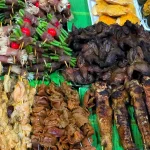Introducing Traditional Laos Dishes
Want to get a handle on the best food in Laos without a ton of research? This guide is your shortcut. We’ve highlighted the top dishes with practical notes so you can get a feel for the local cuisine, know what to look for, and confidently decide what you want to try. For deeper cultural context on Laotian food, be sure to check out our separate culinary guide.
If you’re a serious foodie and don’t want to miss a single dish, our interactive PDF checklist is available for download at the end of this article. It’s perfect for tracking everything you taste.
Table of Contents
Best Food to Try in Laos: Main Dishes
1. Kua Mee (Stir-Fried Rice Noodles)
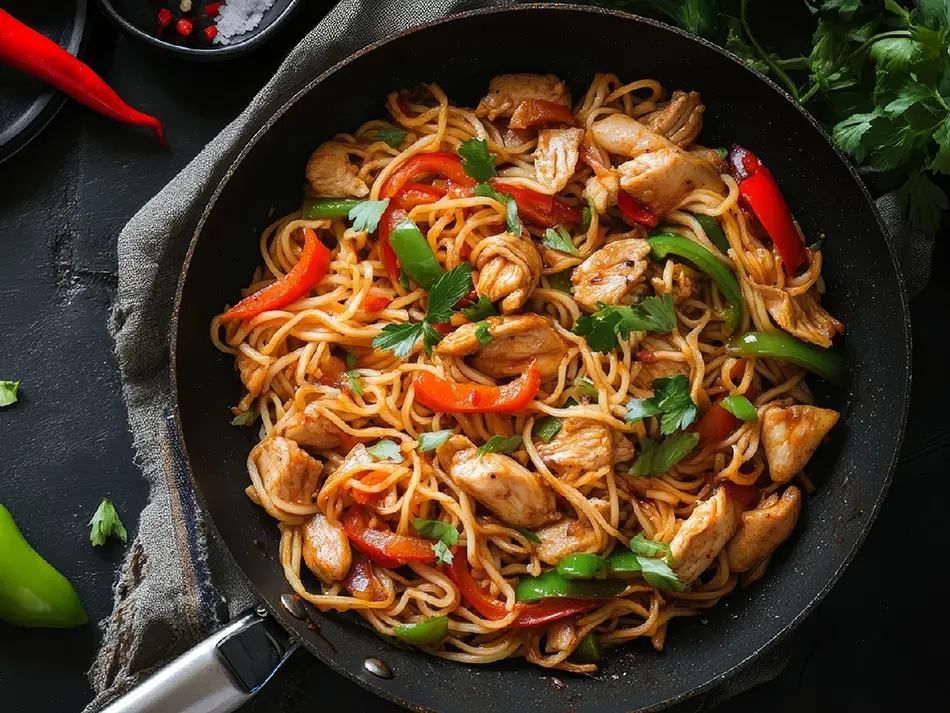
This stir-fried noodle dish is a staple in Lao households and restaurants. It features rice noodles wok-tossed with egg, vegetables like bean sprouts and spring onions, and a protein such as pork or chicken.
The noodles are coated in a savory sauce, typically a blend of soy sauce and oyster sauce, creating a balanced and satisfying meal that is commonly available across the country.
2. Mok Pa (Steamed Banana-Leaf Fish)
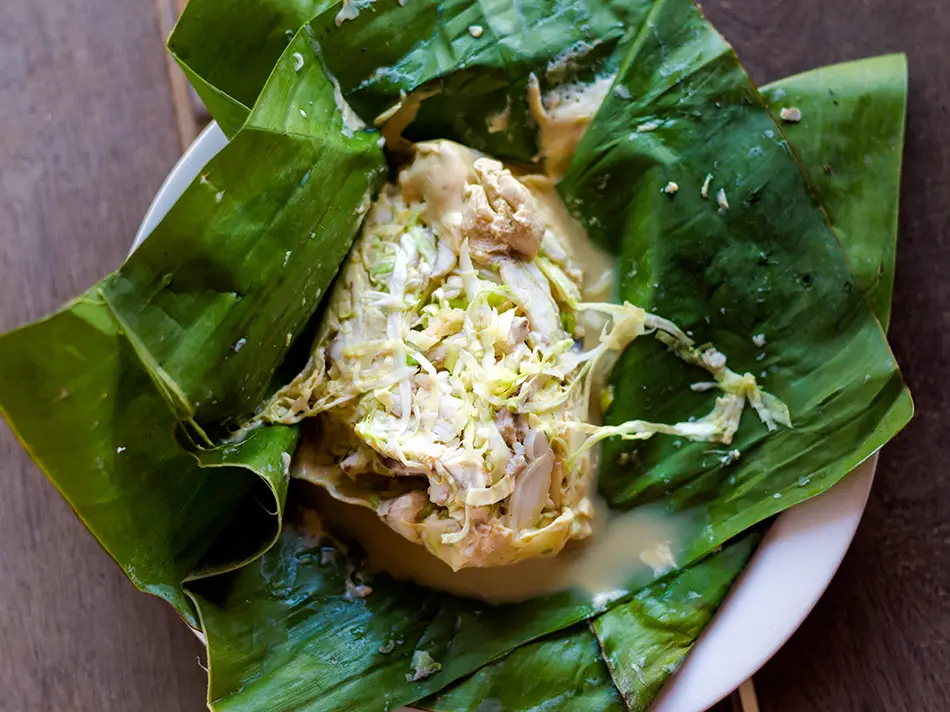
Mok Pa is a method of preparing fish by steaming it inside a banana leaf parcel. Freshwater fish is filleted and mixed with a thick marinade of chopped herbs, including dill, basil, and lemongrass, along with chilies and fish sauce.
The mixture is then wrapped tightly in banana leaves and steamed or grilled over charcoal. The leaf seals in the moisture and imparts a subtle, smoky fragrance to the fish.
3. Ping Gai (Charcoal-Grilled Chicken)
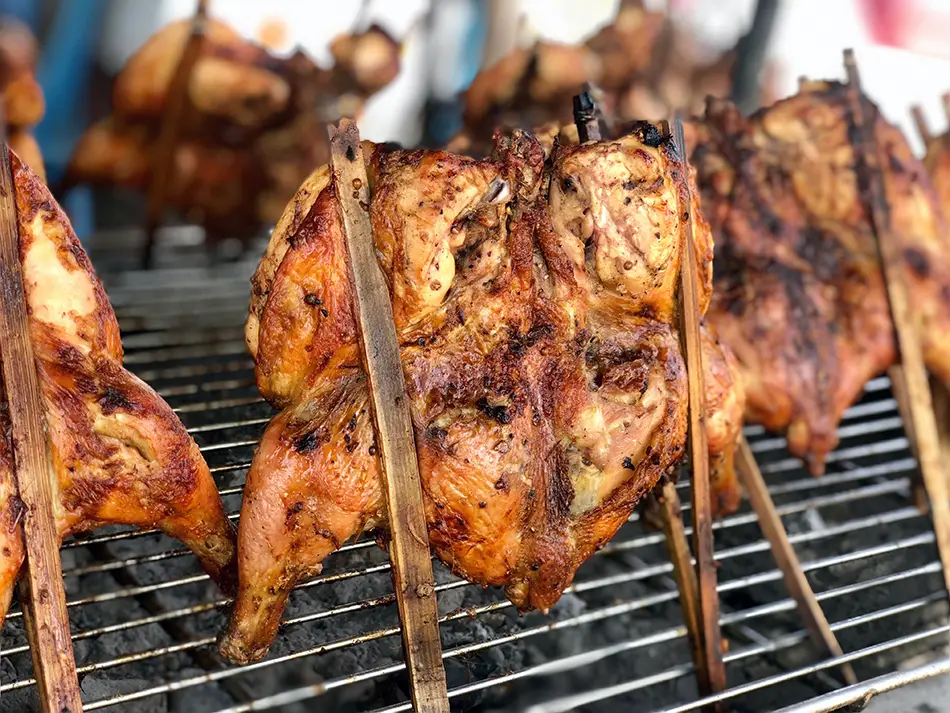
Ping Gai is grilled chicken, prepared in a distinct Lao style. The chicken is marinated for several hours in a mixture of garlic, cilantro roots, black peppercorns, and fish sauce. It is then cooked slowly over a low charcoal fire, resulting in tender meat with a crisp, seasoned skin.
Ping Gai is traditionally served with sticky rice and a dipping sauce, such as Jaew Bong. It’s one of the must-try foods in Laos, especially with warm sticky rice and a punchy dip.
Soups & Stews to Add to Your Laos Food List
4. Kaeng Nor Mai (Bamboo Shoot Stew)
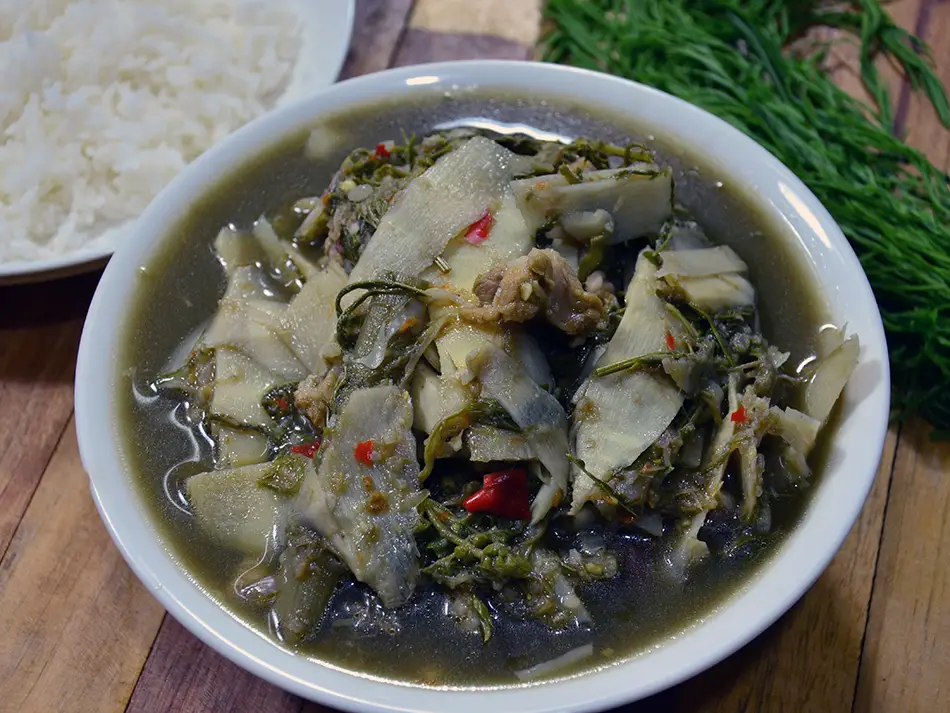
This is a thick stew made primarily from bamboo shoots. Its distinctive dark green color and earthy flavor come from the addition of yanang leaf extract, a key ingredient in many Lao soups.
The stew often includes various mushrooms, local vegetables, and sometimes meat or fish. Its flavor profile is complex, combining bitter, savory, and herbal notes.
5. Khao Piak Khao (Rice Porridge Soup)
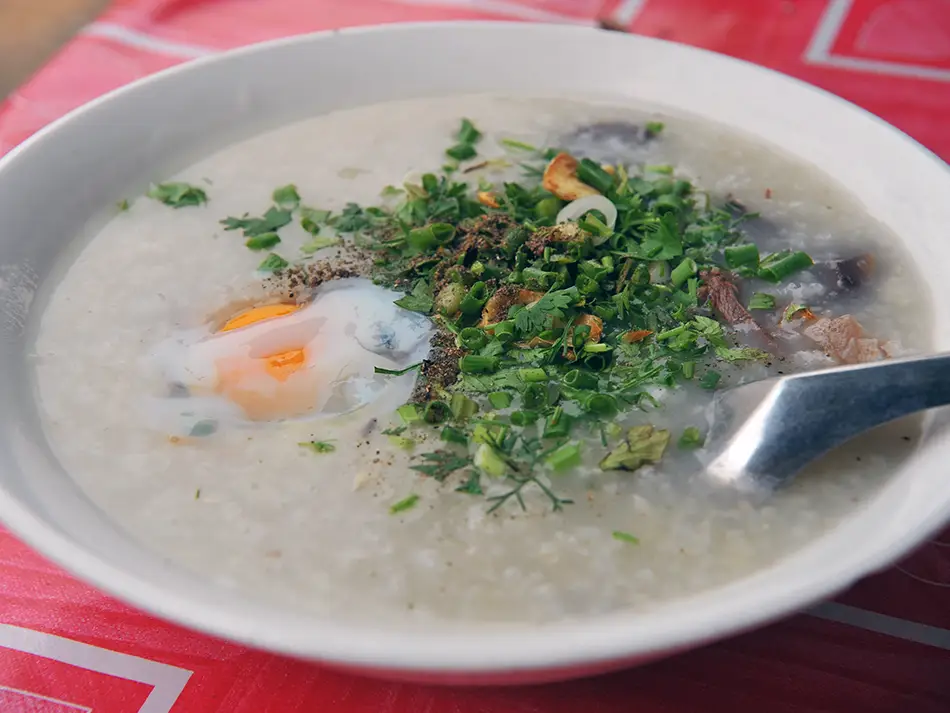
A comforting rice porridge, Khao Piak Khao is a common breakfast dish. It is made by simmering rice in a flavorful broth until the grains break down into a thick, creamy consistency. Typically prepared with chicken or pork, it is served hot and garnished with fried garlic, fresh cilantro, and chopped spring onions.
6. Khao Piak Sen (Handmade Noodle Soup)
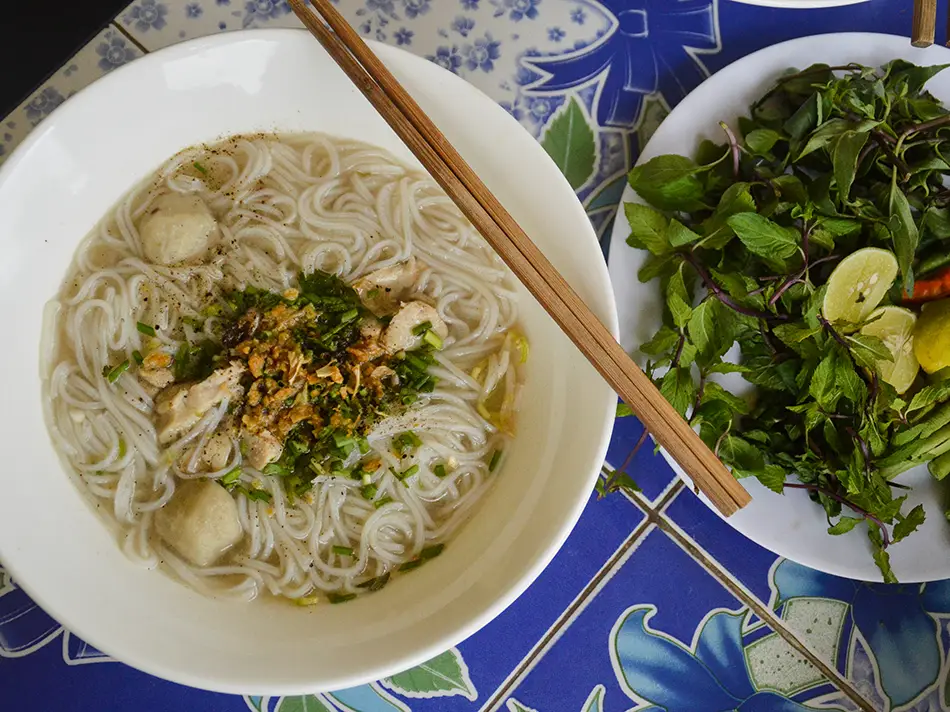
Khao Piak Sen is a noodle soup featuring fresh, hand-made noodles with a uniquely chewy and soft texture, made from a mix of rice and tapioca flour.
The soup itself has a clear, aromatic broth, usually chicken or pork. It is served with shredded meat, and diners can customize their bowl with garnishes like fresh herbs, chili oil, fried garlic, and a squeeze of lime. For many travelers, this soothing bowl ranks among the best dishes in Laos on a cool morning.
7. Khao Poon (Coconut Curry Noodle Soup)
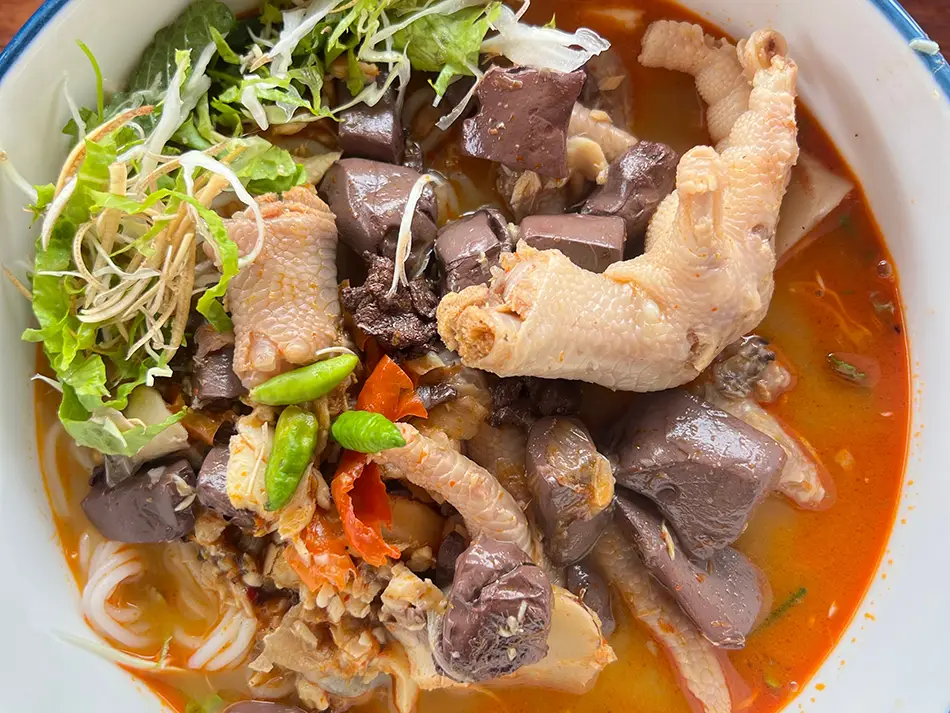
This is a vermicelli noodle soup with a rich, aromatic broth. The foundation of the soup is a curry-like liquid made from coconut milk, red curry paste, and pounded meat or fish.
This broth is ladled over fine rice vermicelli noodles and served with a large platter of fresh, raw vegetables and herbs, such as mint, basil, long beans, and cabbage, for adding to the bowl.
8. Khao Soi (Pork-Tomato Noodle Soup)
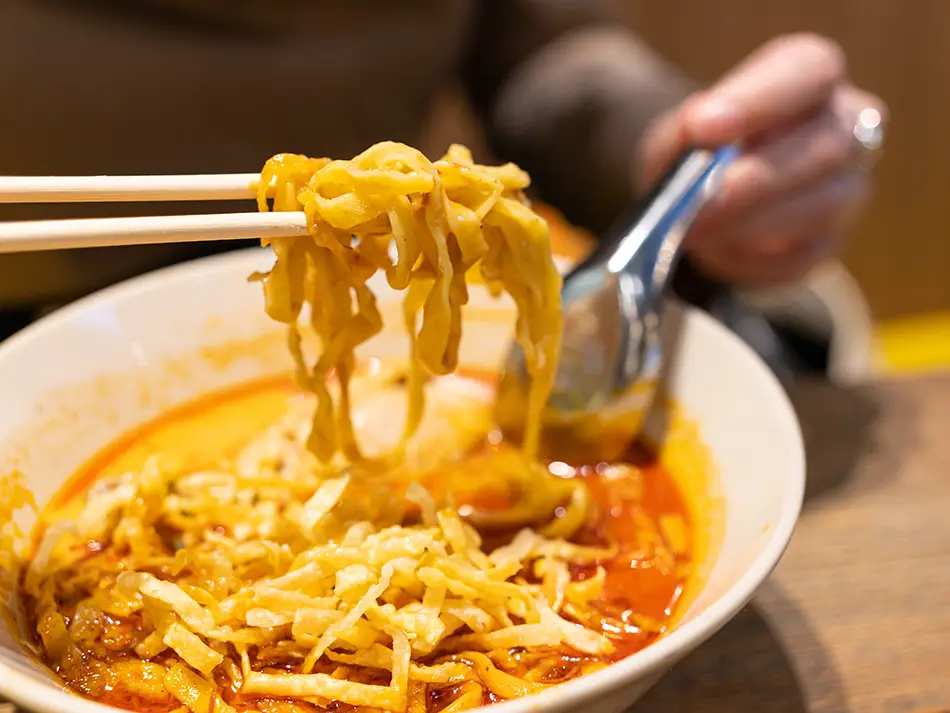
The Lao version of Khao Soi is different from its Thai counterpart. It is a noodle soup with a clear pork broth base, served with wide rice noodles. The defining feature is the topping: a slow-simmered sauce of minced pork, tomatoes, and fermented soybeans. It is savory and slightly sweet, without the use of coconut milk or curry paste. This dish is a specialty of northern regions like Luang Prabang.
9. Or Lam (Peppery Forest Stew)
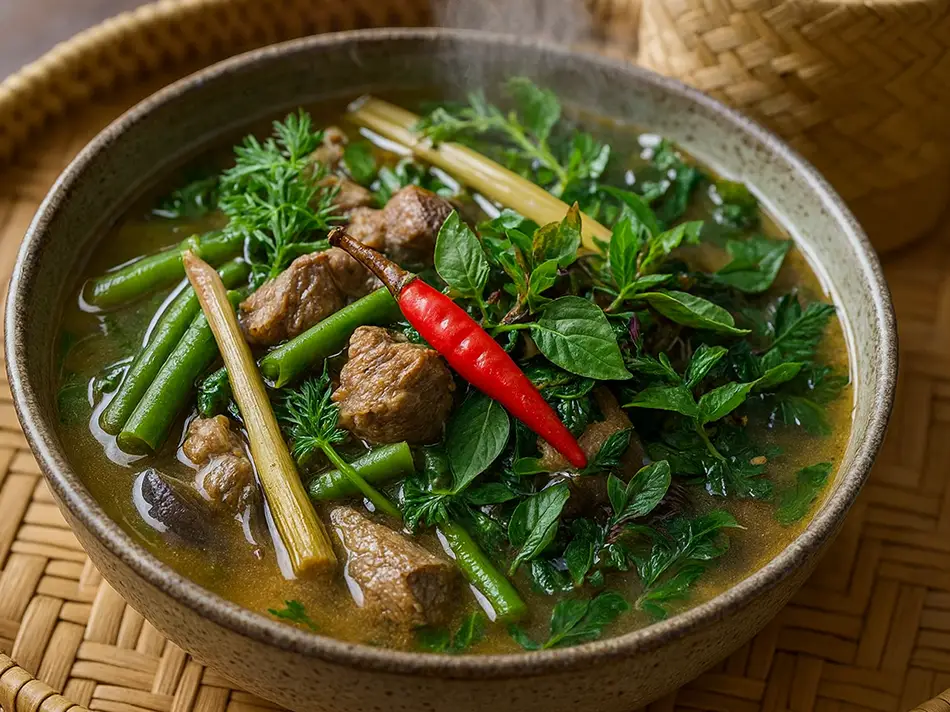
Or Lam is a thick, peppery stew originating from the northern city of Luang Prabang. It is a complex dish made with a base of meat, such as dried buffalo, beef, or chicken, combined with a variety of local vegetables and herbs. A key ingredient is mai sakahn, a woody vine that imparts a spicy, tongue-tingling sensation.
The stew is known for its deep, herbal, and slightly bitter flavor. In Luang Prabang, it’s considered among the iconic foods of Laos.
10. Tom Khem (Sweet-Savory Braise)
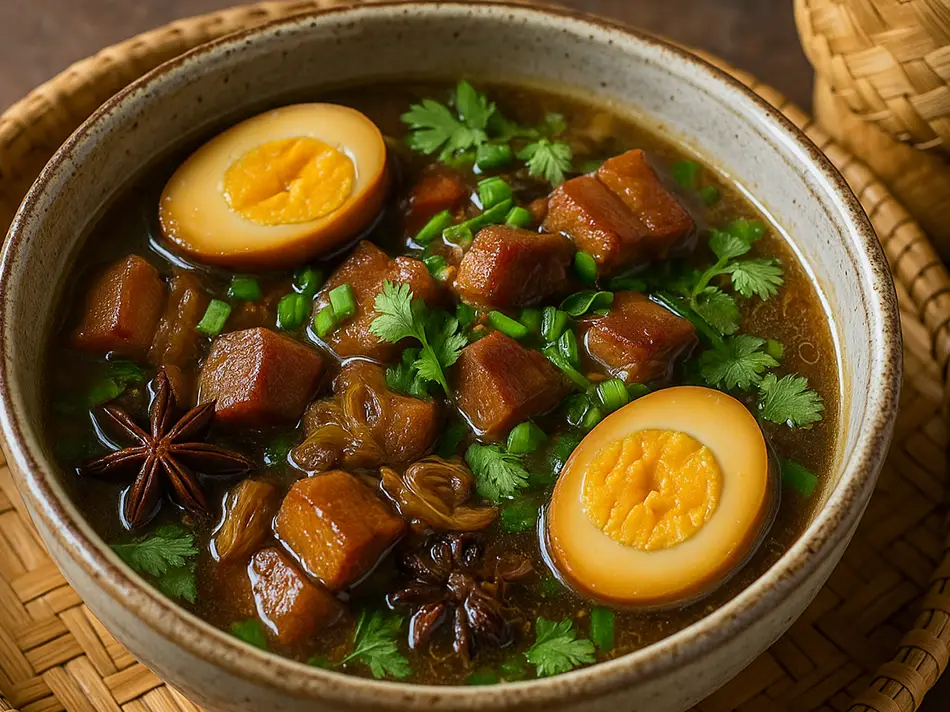
Tom Khem, meaning “sweet braise,” is a slow-cooked dish with a sweet and savory character. It typically features pork, often with hard-boiled eggs, braised in a dark broth made from soy sauce, palm sugar, and aromatic spices like star anise and cinnamon.
The slow cooking process tenderizes the meat and allows it to fully absorb the rich flavors of the sauce.
Small Plates & Cold Dishes: Must-Try Food in Laos
11. Kaipen (Crispy River Weed)
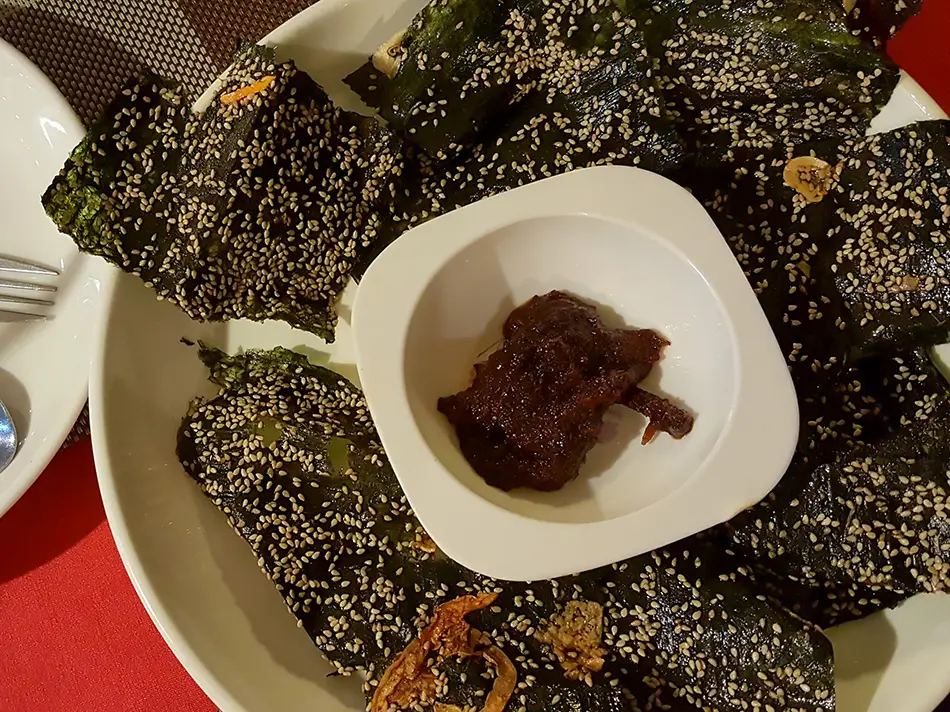
A specialty from the northern part of the country, Kaipen is a snack made from freshwater river weed. The green algae is harvested from the Mekong River, pounded into thin sheets, flavored with garlic and sesame seeds, and then sun-dried. Before eating, the sheets are flash-fried until crispy. It is often served with Jaew Bong for dipping.
12. Khao Jee (Grilled Sticky Rice)
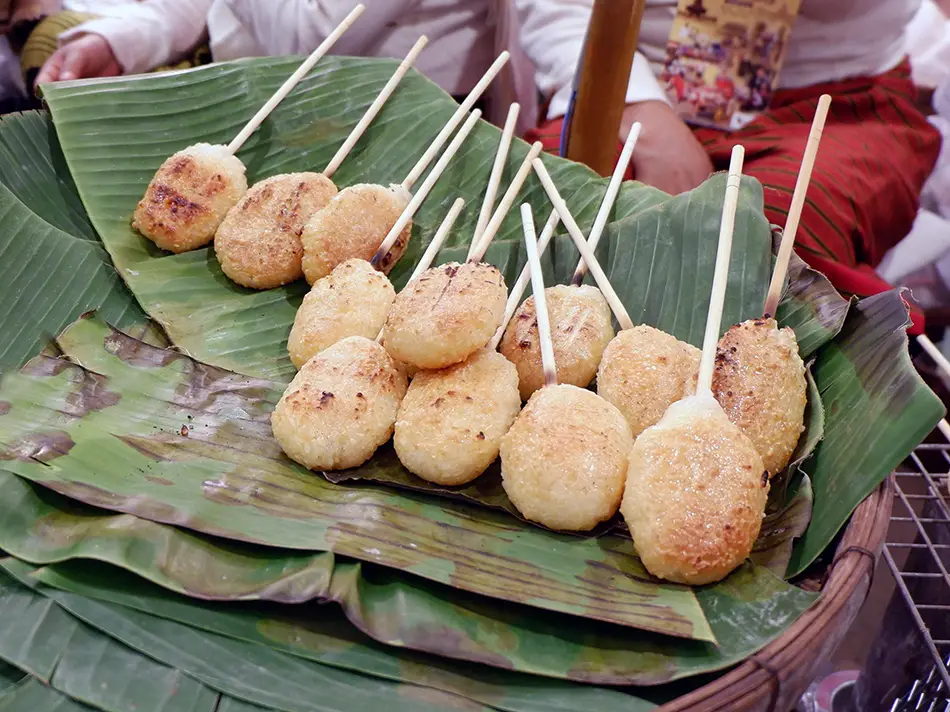
Khao Jee is a simple yet popular street food snack. It is made by taking leftover sticky rice, forming it into a small, round patty, coating it with a layer of egg, and grilling it over a charcoal fire. The grilling process creates a smoky flavor and a texture that is crispy on the outside and soft on the inside. This smoky street snack is a simple introduction to typical Laotian food.
13. Larb (Minced Meat Salad)
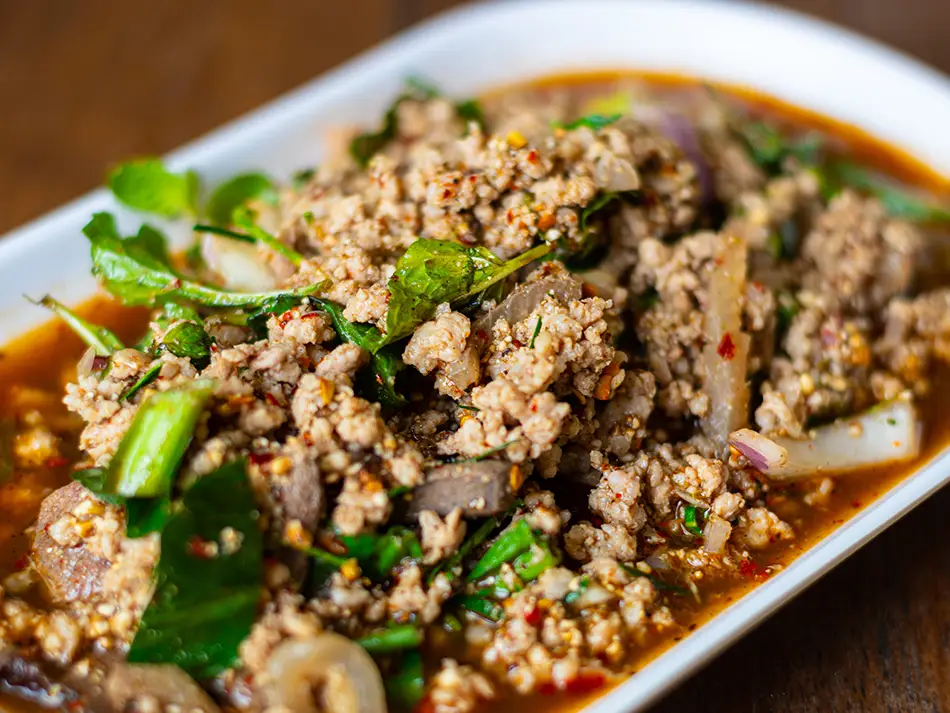
Often considered the unofficial national dish, Larb is a minced meat salad. It can be made with chicken, beef, duck, pork, or fish, which is finely chopped and tossed with lime juice, fish sauce, and a variety of fresh herbs like mint, cilantro, and spring onions.
A key ingredient is khao khoua, toasted ground glutinous rice, which adds a nutty aroma and texture.
14. Miang (Leaf-Wrap Bites)

Miang is an interactive, do-it-yourself snack composed of fresh leaves used as wrappers. A diner takes a leaf, such as lettuce or wild betel, and fills it with an assortment of ingredients laid out on a platter.
Common fillings include diced ginger, shallots, lime with the rind, chilies, peanuts, and toasted coconut, all brought together with a sweet dipping sauce.
15. Nam Khao (Crispy Rice Salad)
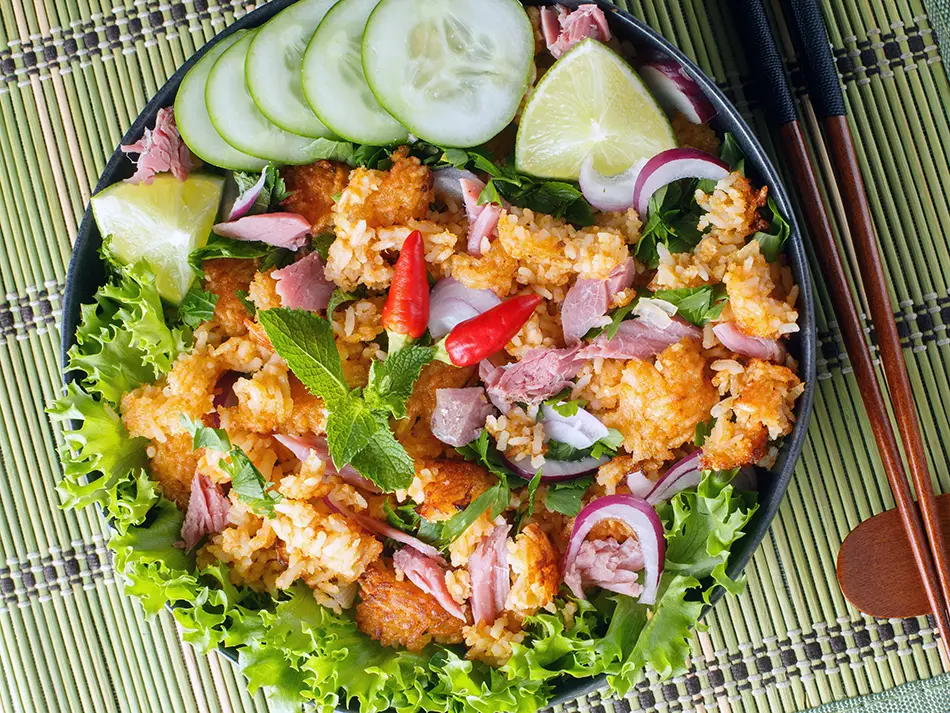
This dish is a crispy rice salad known for its combination of textures and flavors. It starts with deep-fried rice balls made from seasoned rice and coconut. These are broken apart and mixed with sour fermented pork sausage (som moo), peanuts, and fresh herbs.
The resulting salad is a mix of crispy, chewy, sour, and savory components. It’s also one of the famous Laotian foods you’ll spot on menus in Vientiane and beyond.
16. Sai Oua (Herb Pork Sausage)
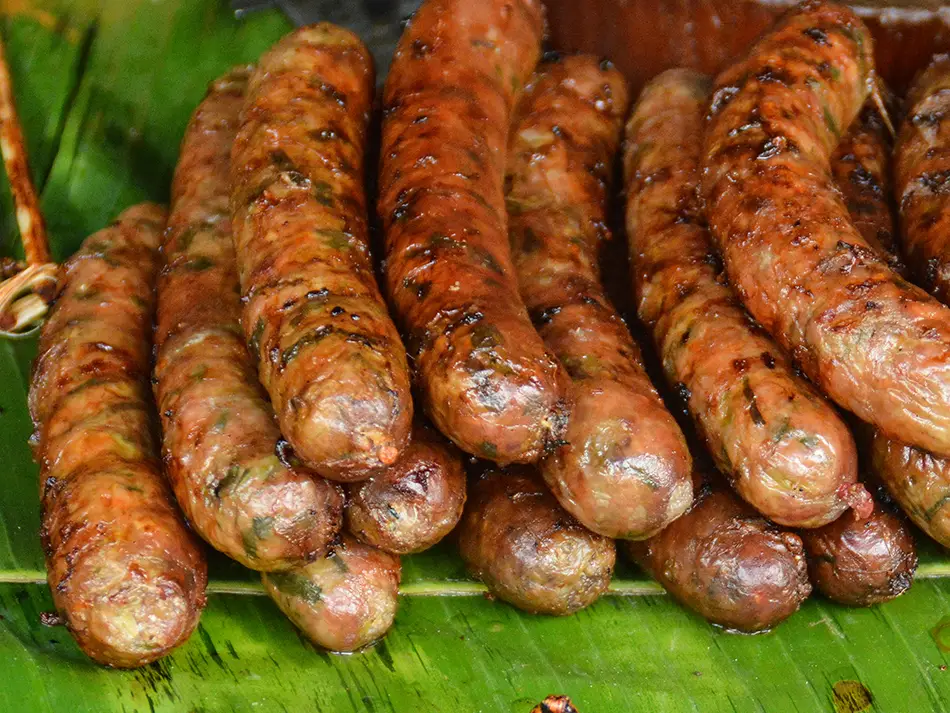
Sai Oua is a type of pork sausage with a distinct, aromatic profile. The ground pork is heavily seasoned with herbs and spices, including lemongrass, galangal, kaffir lime leaves, garlic, and chilies.
The sausage is then typically grilled over charcoal, which enhances its fragrance. It is usually served sliced with sticky rice and fresh vegetables.
17. Sien Savanh (Sun-Dried Beef)
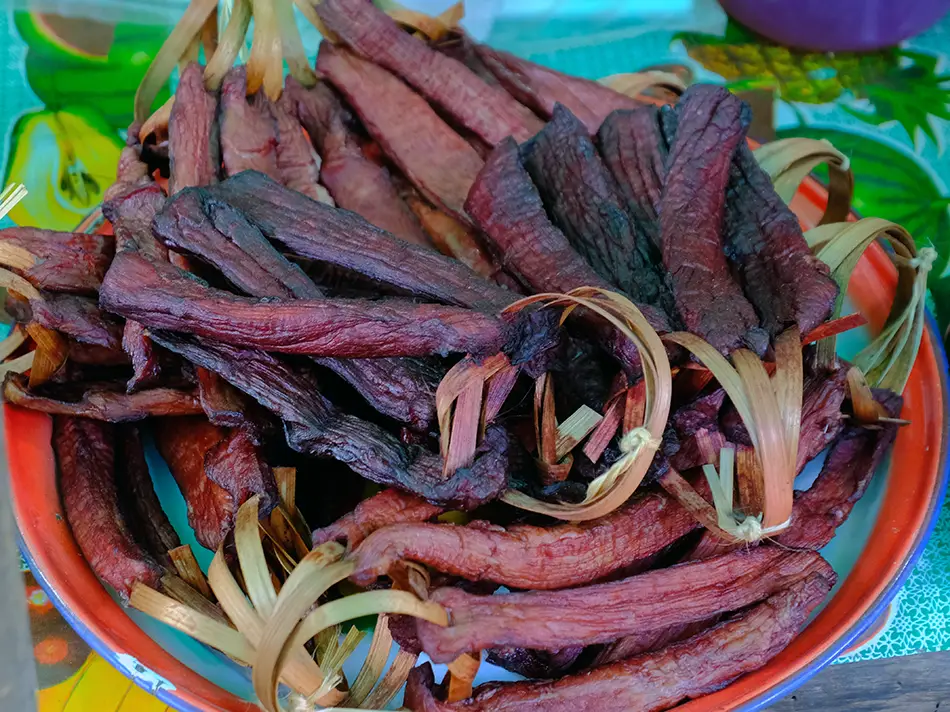
Meaning “heavenly beef,” Sien Savanh is a sun-dried beef jerky. Thin strips of beef are marinated in a mixture of soy sauce, garlic, ginger, sugar, and sesame seeds, then dried in the sun.
The jerky is often flash-fried just before serving to make it warm and slightly crispy. It is a popular snack, often paired with a cold beer.
18. Tam Mak Hoong (Green Papaya Salad)

This is the Lao version of green papaya salad. While similar to its Thai counterpart, it has a distinct identity. The Lao preparation typically uses padaek (fermented fish sauce) instead of standard fish sauce, giving it a more pungent and complex flavor. It is pounded in a mortar and pestle with shredded green papaya, tomatoes, chilies, garlic, and lime juice, and is often made to be very spicy and sour. It is considered one of the national dishes of Laos, especially in its punchy, padaek-rich form.
Famous Desserts & Sweets in Laos
19. Khao Lam (Bamboo Sticky Rice)
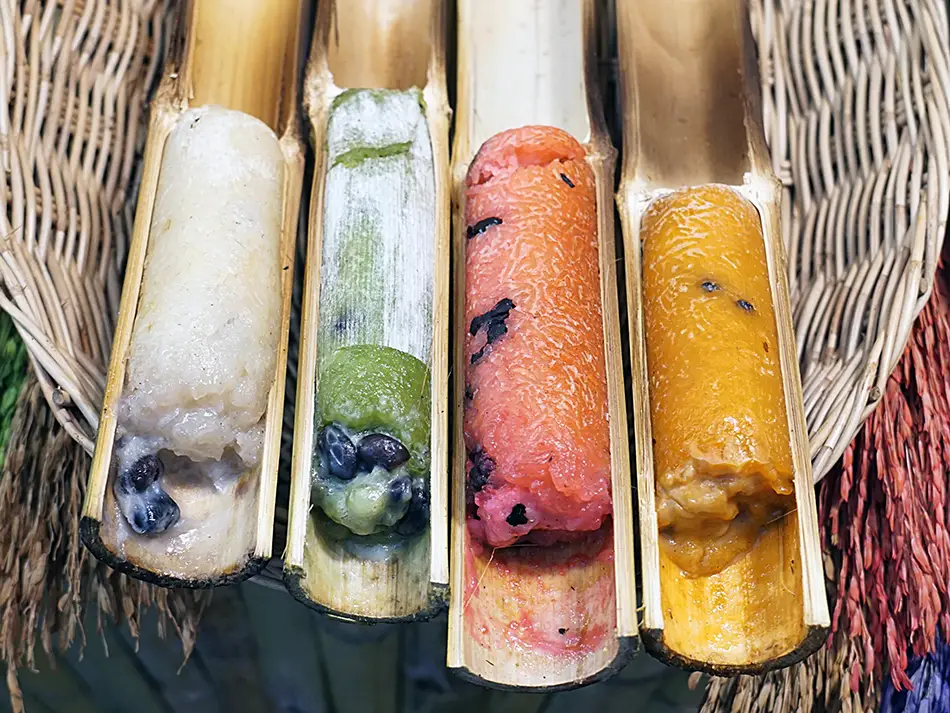
Khao Lam is a sweet sticky rice snack cooked inside a bamboo tube. A mixture of glutinous rice, coconut milk, sugar, and sometimes black beans is stuffed into a hollow bamboo segment, which is then sealed and slow-roasted over an open fire. To eat it, the bamboo is split open to reveal the cylinder of sweet, fragrant rice inside.
20. Khao Nom Kok (Coconut Rice Pancakes)

These are small, semi-spherical coconut pancakes. They are made from a batter of rice flour, sugar, and coconut cream, which is poured into a special cast-iron griddle with hemispherical molds. The pancakes are cooked until they are crispy on the bottom and have a soft, custardy center.
21. Khao Nom Nab (Steamed Sweet Parcels)
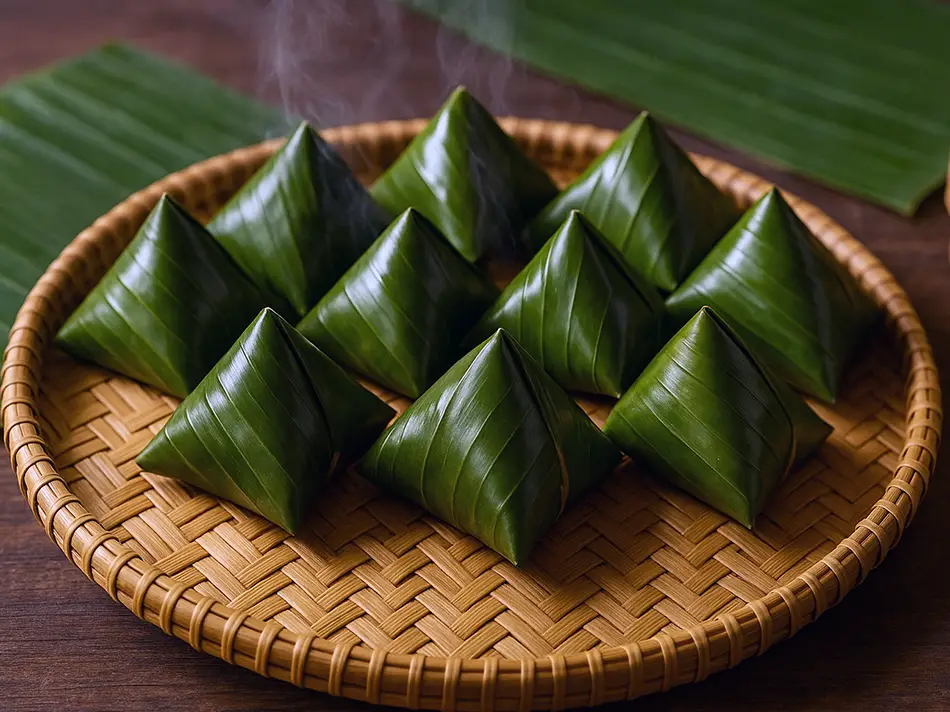
Khao Nom Nab are steamed sweet parcels made from glutinous rice flour. A dough of rice flour and coconut milk is formed around a sweet filling, such as sweetened coconut or mung bean paste.
Each parcel is then wrapped in a banana leaf and steamed, which gives the dessert a soft, chewy texture and a subtle fragrance from the leaf. If you’ve got a sweet tooth, it’s among the lighter foods to try in Laos after a spicy meal.
Authentic Drinks in Laos
Kafae Lao (Laos Coffee)
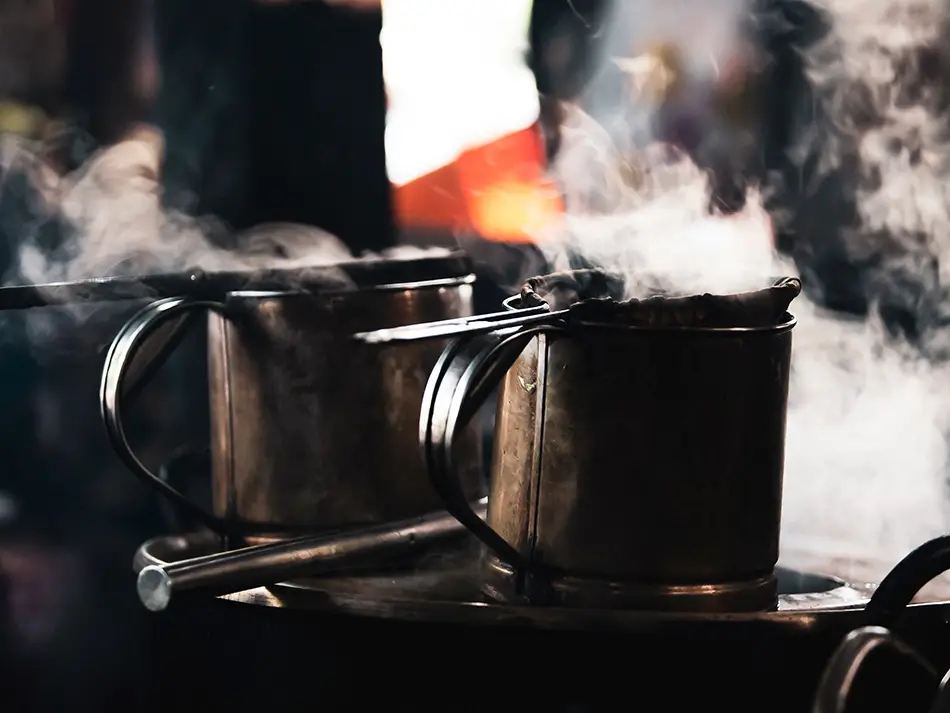
Coffee is a major agricultural product of the country, and Kafae Lao is the local way of preparing it. It is a strong, dark-roast coffee, often brewed through a cloth filter. It is typically served with condensed milk for sweetness and creaminess, either hot (kafae horn) or poured over ice (kafae yen).
Lao Hai
Lao Hai is a traditional fermented rice wine, often referred to as jar wine. It is consumed communally from a single large earthenware jar, with multiple people drinking through long bamboo straws. It has a slightly sweet and sour taste and is an important part of social gatherings, ceremonies, and festivals, particularly in rural areas.
Lao-Lao
Lao-Lao is the name for the local rice whiskey, a potent distilled spirit. It is widely produced, often in small, family-run distilleries. The quality can vary significantly, from strong, unrefined versions to smoother, commercially bottled products. It is a clear spirit and is a common fixture in local life.
Keep Track of Your Gastronomical Trip in Laos
You now have a compact roadmap to the best food in Laos.
Download the interactive PDF checklist of best food in Laos to tick off dishes, rate them, and keep notes, and jump to our full culinary guide when you want deeper context.
Enjoy exploring markets and street stalls!
And safe travels!

